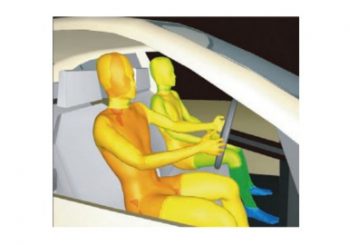
Developers of SC/Tetra, one of the CFD codes we use to solve complex fluid flow and thermal management challenges have gone quite far in terms of human body thermal comfort CFD analysis. This modeling environment is called JOS (Joint System Thermoregulation) and it is designed to provide top-notch human body thermal modeling in environments like a car, bus, an airplane. Furthermore it is just as good as simulating human comfort in built environments as in automotive applications.
Development of JOS was motivated by the ever increasing need for more efficient HVAC (Heating, Ventilation, Air Conditioning) systems.
More efficient air conditioning for electric cars needed
Growing numbers of electric cars are welcome, Tesla Model S and Nissan Leaf and others are already here and more models to come soon. When traveling in an e-car the driver wants to increase range a little bit and pushes Eco button, the very first thing management software of car does is that it cuts the power of air conditioning.
As a consequence here is the increasing need for more efficient air conditioning and software developers in Japan thought they can add value to their code and help their users like us if they create an accurate human body thermal model. They were focusing on creating a tool with automotive applications in mind but as I mentioned thermal comfort CFD analysis of buildings are also in focus.
To do that one thing is obviously needed: the understanding of the thermal behaviour of the human body. And of course a good methodology to turn that understanding into software code. This understanding was based on a model developed by scientists at Waseda University, Tokyo. This original model contains detailed blood circulation data, heat released from body by radiation, conduction and evaporation. Even pulse independent oscillation of blood vessels is incorporated. Generally speaking, they have the finest details as well.
Finest details of the human body thermal operation
Let me share some interesting facts with you regarding thermal behaviour of the human body. If temperature of the surrounding environment is lower than skin temperature, the body looses heat by convection, radiation and maybe evaporation (which means sweating in the common language). Blood vessel system also helps in because tone of blood vessel walls decrease which enables larger blood flow rate through larger vein and arthery cross sections. This way resistance against blood flow decreases and more blood gets closer to skin surface where it can cool down.
However if temperature of surrounding environment is higher than skin temperature, the only way the body can loose heat is sweating. Dressing is also important and can be taken into account. Light clothes made of cotton do not prevent sweating but do not let radiation from the sun go through.
In the computational model we, as users need to give five parameters to make a human body thermal comfort CFD analysis work. These are the age, gender, size of body which is characterised by body fat rate and the basal metabolic rate. This last one is shortly BMR which must be given in the unit of W/m2 [1]. Since in most of the simulated cases humans wear clothes too, type of dressing must be accounted for by its insulation capabilities and the area of the body covered.
Segmented body model
Within JOS human body is made of 17 segments and within each segment there are blood vessel models, plus in limbs there are veins running closer to skin so that heat loss through sweating can be calculated.
The head on the other hand does not have only two segments (core and skin) but four: core, muscle, fat and skin. This enables an even more detailed approach to the thermal conditions of the head.
This is needed because head is not covered by insulating material while in a car or airplane and the head produces large amount of heat, especially when it is in use. I mean used for thinking. Blood vessel system in the head is extremely complex in order to transfer heat produced by the brain to the outer skin layers and to release it to the environment.
Detailed settings applied on detailed body models
So when all these boundary conditions are in place, what we need now is the body itself as a geometry. We can use four preset body positions: standing, sitting (driver), sitting (passenger) and one sitting on the ground.
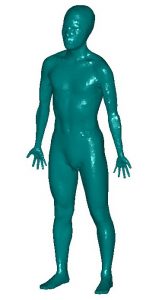
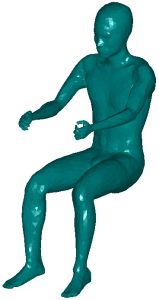

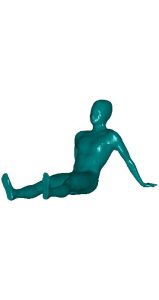
It is an interesting background information how these body geometries were created. Since the developers did not want to license body geometries from third parties, they asked students of the university in Tokyo to pose for the laser scanner. The point cloud was then wrapped within SC/Tetra itself to form the bodies ready to be placed into a geometry and meshed.
I could use other body models too. In this case I need to name all the regions of body segments so that the software knows where head, neck, chest, back, arms and legs are.
Results specific to human comfort studies
JOS-specific results are skin temperature, rate of sweating, heat flux through skin to the environment, temperature of parts (core and skin, for the head muscle and fat too) of each segment, volume flow of blood near skin surface.
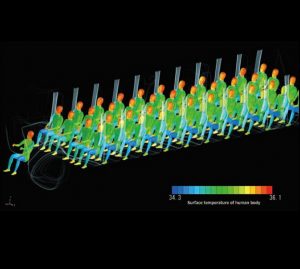
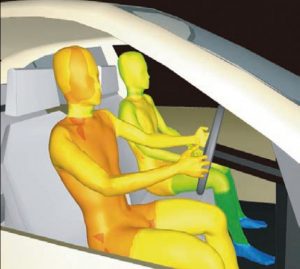
JOS is performing very well in case of automotive simulation studies. We even used it to perform comfort studies of hot work environments like the workspace of casting machine operators.
Actually JOS has been the only feature of a CFD code so far I read in the the user’s guide what explicitly not to use it for: to simulate a sauna.
Dr. Robert Dul
References:
[1] SC/Tetra: Basics of CFD Analysis – Joint System Thermoregulation
